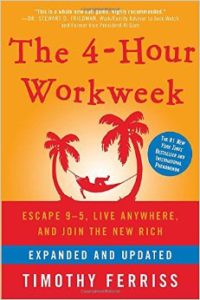Summary: The 4-Hour Workweek – Tim Ferriss

 The 4-Hour Workweek
The 4-Hour Workweek
Book Title: Escape 9-5, Live Anywhere, and Join the New Rich by: Timothy Ferriss
I. One Sentence Summary of the book
This book deals with what Ferriss refers to as “lifestyle design” and rejects the traditional “deferred” life plan in which individuals work long hours and take few vacations for years and save money so as to relax after retirement.
II. Book Overview
Ferriss got the ideas in this book while working 14-hour days at his sports nutrition supplement company, BrainQUICKEN. Due to frustration as a result of overwork and lack of free time, he took a 3-week sabbatical leave to Europe. During that time, he travelled throughout Europe, Asia, and South America. His personal escape from a workaholic lifestyle was the genesis of the book.
The release of this book moved Ferriss’ blog to the Top 1000 on Technorati. 4HWW is read by many of the top tech CEOs in the world
This book first appeared in the pre-economic crash world of 2007 and was later updated in 2009. The Tim’s style of writing is built on brief, hard-hitting, cheerleader and chant sentences, which seem perfectly suited for great inspiration
Tim’s work is inspiring, but in a self-enclosed manner. His irrepressible optimism and self-confidence gives readers more confidence in themselves.
III. Recommended for
Wonderful, Compelling and Disturbing
Tim Ferriss, a cultural phenomenon, a magazine writer, and the author of “The 4-Hour Body” and “The 4-Hour Chef” among others books made a wonderful, disturbing and compelling presentation in his first appearance. He writes like an adolescent genius. His soothing tone, originality and firmness will captivate your attention right from the first sentence. His absolute bravery is expressed in his subtitle: Escape 9-5, live anywhere, and Join the New Rich.
Readers usually categorize Ferriss’s work among books that are meant to teach time management or realizing one’s dreams. In most of his books, his texts usually start by urging you to have a definition of the exact thing you really want.
In this book, Tim walks you through the four (4) stages of developing a four-hour workweek (Definition, Elimination, Automation and Liberation) for yourself. For each stage, he provides guidance, tools, and examples of success and failure. Tim’s attitudes are to build your confidence in him. And after reading this book, you will know about his successes, and decide whether or not “you can do it”
IV. Author Biography

Ferriss offers his own specific definitions of “aspiration terms” like “new rich” and pushes you to engage in highly focused “lifestyle design.”
V. Lessons
1. Cultural Phenomenon
If you think everything Ferriss touches turns to gold, you may be right; this seems to increase his frenzied energy and self-promotion. This is his first book and it had gained top rank of The New York Times bestseller list. His next book titled “The 4-Hour Body” did likewise. His most recent work, “The 4-Hour Chef”, has gained prominence on Amazon. Ferriss also teaches at Singularity University at the NASA Ames Research Center in Silicon Valley. He is boundless, and ever-ready to take on new tasks as well as learning new cuisines, languages or outdoor skills. Though his authorial voice could sound annoying, yet, you can’t deny the fact that he has been able to transform you through every single thing he advises you to do into a well-compensated reality.
“Ferris believes in setting somewhat unrealistic goals and he offers a detailed “dreamline” strategy you can follow”
Ferriss does seem to enjoy the sound of his own voice. Like most self-help books, “The 4-Hour Workweek” book is not too voluminous, just the size it should be. However, you can’t accuse Ferriss of being wordy to make a magazine article to book length. He functions in a very original way. He has much to say and most of it is helpful. The vital Ferrisian element that readers must strive to broaden to achieve even 1/10 of his success is not self-confidence, although having that wouldn’t hurt. What is of significance – what you can do to envision yourself in the Ferris mode – is utter unselfconscious brashness. If you can self-promote as genuinely as Ferriss can, with a smile, I’m-here-to-help-energy, you can achieve anything. Ferriss has veritable analytical, entrepreneurial skills. In truth, he seems to be a self-taught prodigy in that realm.
2. “DEAL”
Ferris does provide a workable strategic plan, and he spares no detail in laying everything out and explaining how to be a part of the new rich. He would walk you through the four stages of developing a four-hour workweek for yourself – “Definition, Elimination, Automation and Liberation” (DEAL). In each of the stages he provides advice, tools and instances of success and failure. Definition calls for figuring out what you want, conquering fear and taking action. Ferriss is convinced by setting quixotic goals =, and he provides a detailed “dreamline” strategy that you can emulate. Elimination dismisses management in exchange for productivity and forgoes efficiency to gain effectiveness. Regarding automation, Ferriss maintains that you can replace yourself and the time you set aside by systematically automating what you do while preserving cashflow, getting tasks done and moving into a new life. Liberation appeals for letting go of control, an especially difficult challenge for most entrepreneurs: thinking out of the box: and attaining new goals, such as mini retirements and “freedom of location”.
“Ferriss urges, “What you do is infinitely more important than how you do it”. To further explain this, he turns to the Pareto Principle, or 80/20 rule, which claims that 80% of “society’s wealth and income” arises from and accrues to 20% of its people. Ferriss provides informative examples of incorporating the effects of this principle, which relates in many other areas of life. “Depending on the context,” he explains, that 80% of the consequences arise from 20% of the causes,” that 80% of results come from 20% of the effort and time.” And that 80% profits derive from “20% of the products and customers.” Ferriss applies this principle with remarkable intensity. He urges you to do the same – to learn which “20% of sources” generated 80% of his “problems and despair.” He is adequately intelligent – and self-believing – to ask the crucial opposite of that question: “What 20% of sources” could lead to 80% of the results and happiness that he is hoping for.
While his precedent of how he applies this principle – like immediately getting rid of a fraction of unproductive customers – may seem less compelling than his probing questions, Ferriss makes a strong argument: Choose from your life everything that doesn’t contribute to your goals and happiness. Be relentless. Note which efforts and things you endure have a major effect on your work, life, perspective and success.
Much is natural to him; however, you can’t accuse him of pure luck because clearly, he works really hard. On his road to explaining his system, Ferriss honestly portrays some of his highly diverting failures amid the adventure he makes of lifestyle design. Though he exhibits the enthusiasm of an amped up 8th grader, he explains that you will need a huge amount of discipline to make his methods for you. His vision is so all-encompassing that even tasks like checking email at set times or negotiating aa telecommuting job become part of bold self-creation.
3. Pragmatism
The book’s restricted pragmatism and its rejection of obvious objections make it somewhat adolescent and disturbing. Aside from being an entrepreneur, investor, speaker and author, Ferriss has won a gold medal in the 1999 Chinese Kickboxing National Championships. As he said, he won by drastically cutting down his weight. He also pushed smaller opponents off the platform to have them disqualified. This seems like gaming the system to attain paper wins and not real ones. However, even that suspicious boast highlights his fundamental lesson. Seek and nurture your passions, when you do, look for a less obvious way to thrive, don’t sweat the ethical fine points. Believe in the results and boldly boast your accomplishments without mentioning how you took shortcuts. Ferriss has veritable analytical, entrepreneurial skills. In truth, he seems to be a self-taught prodigy in that realm. Much is natural to him, however, you can’t accuse him of pure luck because he works really hard. If you question his work ethic just look at the size of his books. Yet he underestimates how difficult analytical entrepreneurism can be for most people who simply cannot follow what he advises. Most people can’t stop earning the rent long enough to reinvent themselves and their lives. A few have the early success gave him the cushion to launch his other ventures.
4. Fervent Fevered Advice
Regardless of whether you are able to apply his ardent advice to your life, Ferriss turns out to be quite amusing, a mark most self-help or self-reinvention books clearly lack. He is very readable. You may get tired of his constant self-glorification. The repeated short sentences may make you grow impatient. You may even skip groups of pages because whenever he makes a discerning point, he never fails to make it two or three times again to ensure that you acknowledge that he is indeed capable of insight. Nonetheless, you will smile most of the time while reading. Take note of his more notable ideas and in the end, you’ll be glad you entered his universe.
VII. Personal Takeaways
- Most of us have the idea that we are supposed to work until we are 60, then retire and live the good life. Tim does a great job pointing out how backwards that idea is, and gives lots of suggestions for how to change your life to accommodate. He calls those who have done so the “New Rich”, as they are rich in life – which is not related to being rich in dollars.
- This book by Ferris gives an in-depth understanding that it is good to outsource jobs to third party firms. Companies or individuals that outsource jobs will not only have rest of mind but also will achieve the following:
- Reduce and control operating costs
- Improve company focus
- Gain access to world-class capabilities
- Free internal resources for other purposes
- Streamline or increase efficiency for time-consuming functions
- Maximize use of external resources
- Share risks with a partner company
- Take ‘mini-retirements’ throughout your life instead of planning to retire at the end of your life (which I probably wouldn’t do anyways). This means every 5 years take a year off to go on a big adventure. Tim’s point is you don’t need to be rich to do this, and gives a lot of advice on how to go about it. I don’t think he’ll convince too many people, but it does sound like he’s starting to have a following.
- Be a business owner – not a business runner, outsource jobs to people. One gives you lots of free time – the other consumes your life (which I can currently attest to)
- Time is your most valuable asset. Tim gives a lot of good tips for time management – which aren’t unique, but every time you read them helps you. The ones that stuck out for me were:
- Only check email 3 times a day at set intervals
- Outsource everything you can to 3rd parties
- Batch activities like paying bills for max efficiency
- Give employees autonomous rules/guidelines
- Avoid meetings whenever possible – use emails instead (this works wonders!)
- Try to start businesses that can be completely outsourced after you’ve set them up, so they run on auto-pilot. The author did it with a nutrient company – I’m dubious on this one though.
- 80/20 rule. 80% of your revenue probably comes from 20% of your customers. You can save a lot of time and make more money by focusing where it matters – on the 20%. This applies to most things in life, and although I’ve read it before it was a good refresher.
- Reach out to important people. Don’t be afraid to reach out to important/famous people for advice. They are often more accessible than you think. Tim had good tips for this – like always uses phone’s and not emails.
- Avoid excessive information: too much information input can overload you, so avoid reading news on subjects that don’t relate to what you do. If something important happens in the world you will hear about it – or its good conversation when you meet with a friend (“what’s new in the world?”)
- This book equally highlights the benefits of outsourcing jobs to third party firms; some of the benefits are:
- Cost advantages
- Faster and better services
- Improved efficiency
- Access to skilled resources
- Focus on core areas
- Save on infrastructure and technology
- Time zone advantage
VII. Other learnings to look out for
- According to Ferriss, life exists to be enjoyed — the most important thing is to feel good about yourself.
- You have to learn how to be more productive with e-mails.
- You have to reduce the jumble in your life.
- If are unable to define or act on something, just forget it.
- You have to realize the value of a Virtual Assistant.
VIII. Final Words
Tim explains to us that time is our most valuable asset. Tim gives a lot of good tips for time management – which aren’t unique, but every time you read them helps you.
While achieving what Tim has achieved is not an easy task, you will gain a lot of useful insight from reading his book.
For more information about the book and Tim, you may click the link below.
IX. What other people are saying
- Two people I really believe in and trust were telling me I had to read this book. So I sucked it up and ordered it from Amazon (who, I believe, I single-handedly keep in business, though my scant GoodReads list may not yet reflect it). So I decided to give it a shot and ate it up in a weekend. A fun and easy read. The premise is basically this: so many of us “follow the rules” and strive to tolerate the best job we can get for 40 years, holding off for retirement. Tim Ferriss, the 30-year-old author of this book, posits an entirely different worldview and a straightforward plan for achieving living it – set up automatic profit centers, and take “mini retirements” throughout your life (which he does, and explains in fun and interesting detail. He’s studied tango in Argentina, martial arts in Berlin. What a cool reading!
- The things I most enjoyed about this book were the practical tips. I was familiar with many of them, having an internet entrepreneur background, but still found plenty of interesting information to make it worth my while. Lots of good detail on the travel side too. He gives you not just the theory, but the web addresses and the exact plan for setting up your own online business and “mini-retirement-lifestyle.”
- I found this book on a recommendation from a good friend, and if it wasn’t for that I might have put it down right away, because the tone is very persuasive, and the author makes a lot of big claims with little substance. That being said, the author must be a smart guy because there is a lot of good stuff in this book.
- The book that changed my life a few years ago. My aim was to be location independent, after a number of businesses and investments that tied me to one place. 5 years later, I am location independent and a full-time author-entrepreneur. This book helped me see it was possible.
- One of the few books I have read more than once. Timothy Ferriss does an excellent job of explaining the lifestyle and methods of the new rich. Not only that, but he provides web addresses, phone numbers, and more for manufacturers, drop shippers, and mentors. This is a life-changing book for any person involved or interested in business.

 The 4-Hour Workweek
The 4-Hour Workweek 





 Independent
Independent




